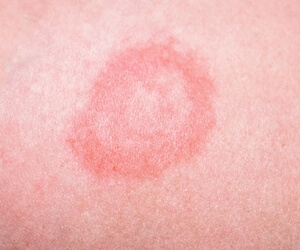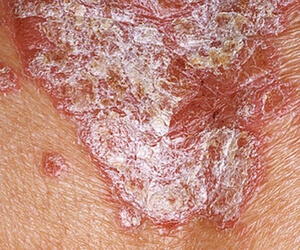Psoriasis is characterized by periods of remission and exacerbation. Inflammation of the skin occurs in several stages: primary, progressive, stationary, regressive. This separation will help in diagnosis and proper therapy.
Interesting to know
Psoriasis is a genetic disease. About 10% of the population has characteristic DNA diseases, and only 2% of them show signs of skin dysfunction.
The following factors cause pathology:
- strong emotional stress;
- injuries;
- alcohol abuse, smoking;
- unbalanced diet;
- infectious and other diseases;
- certain medications;
- endocrine diseases;
- prone to allergies;
The first signs of the disease appear due to the wrong response of the immune system, which reacts to the epidermal tissue as foreign elements. Review the stages, symptoms, and treatment regimens of psoriasis.

The initial stage of psoriasis
The first signis the appearance of an acne(papules). Round shape, red or pink color. A blue color may appear in the lower extremities due to slow blood flow. Papular formations are small, about the size of a head.
The initial stage is characterized bymany papuleswith well-defined boundaries. White scales are also visible. They are easily separated from the surface when touched. Papules can coalesce to form larger elements.
In early remission, the lesions become pale. Affected skin areas are partially colored. In children, this stage of psoriasis is often confused with the manifestations of allergies or diathesis. The rash may be accompanied by severe itching. Symptoms that can be used to diagnose psoriasis:
- When shaved, the surface of the plate becomes whitish, resembling a rubbed drop of stearin, the scales break;
- If you continue to shave the stain and remove the scales, a bright red surface will appear;
- Small drops of blood appear when you shave.
Progressive stage of psoriasis
In the progressive stage of psoriasis, the following symptoms appear:
- Papules continue to be covered with white scales and turn red. They peel off easily, you can see a smooth red layer of skin underneath. Blood is visible when damaged.
- With exacerbation, papular elements grow and coalesce. They are clearly different from healthy skin areas.
- Itching is worse. But it passes during the transition of the process to the stationary phase. Painful and obsessive itching that interferes with sleep and daily activities. If you just scratch the cover, injuries and new plaques will appear. The appearance of new plaques at the site of injury is Koebner's syndrome. The number of itchy manifestations gradually increases, covering the body, limbs, head.
- There are no scales on the edges of the plaques, it is hyperemic, which indicates the continuation of the inflammatory process.
Results
Psoriasis can affect the joints (psoriatic arthritis). Then there is severe pain in the joints, deformity, if the process remains untreated.
stationary stage of psoriasis
The main feature of the stationary stage of psoriasis is the absence of new elements. Positive changes come with proper treatment.

Clinical manifestations:
- itching disappears;
- no injuries (Koebner's symptom disappears);
- crusting may increase.
All spots stop growing. In the progressive stage, if there is a border without scales on the boards, in the inactive stage, the entire inflamed surface of the whole will be peeled off, gaining a characteristic psoriatic appearance.
Scales are characteristic of the final stage of inflammation. At the beginning of the pathological development, the scales do not correspond to the progressive growth of the plaques and cannot completely cover them. Half of the cases showpseudoatrophic corolla.
pseudoatrophic corolla
It looks like a light border around the element, consisting of a layer of corneum and a structure no more than two millimeters wide, reminiscent of rough tissue paper.
Regressive stage of psoriasis
In the regressive phase of psoriasis, the psoriasis cycle ends. Notable Features:
- the inflammatory process stops, the inflammation disappears;
- boards are gradually resolved;
- peeling stops, stupid elements are corrected;
- The rash becomes pale pink, gradually changing color;
- papules may still remain on the arms and elbows.
No scars or atrophy remains in the affected area. There may be temporary hyperpigmentation or areas deprived of pigment at the site of the rash.
Remission occurs after complex therapy.Relief period is individual. The latent disease can last for months or even years. Outbreaks appear to be exacerbated during the winter, with only a few forms of psoriasis occurring.
Treatment of psoriasis at different stages
Treatment of any form of psoriasis consists of general and local treatment, physiotherapy and dietary regulation. Necessary in the initial stage of therapy:
- to give up bad habits;
- Strictly follow a therapeutic diet;
- Use ointments containing vitamins A, D3, hormones;
- use systemic and sedative drugs;
- Ultraviolet therapy is performed.
If the plaque is on the scalp, the doctor prescribes shampoos based on resin, zinc, selenium sulfide.
All remedies should be used as directed by a physician. Long-term use of drugs (especially with resin) can irritate the skin. Funds must be changed every 7 days.
Early psoriasis treatment
The effectiveness of early treatment interventions depends on when the patient sees a doctor and begins treatment.
In most cases, early therapy prevents the disease from becoming chronic.
Experts recommend the use of salicylic acid ointment. It is an anti-inflammatory and antimicrobial drug that has a beneficial effect on the affected skin areas. With the help of keratolytic effect, the ointment will clean the plaque from the ceramic part. Naphthalene ointment will help get rid of itching.
Medications are usually prescribed:
- tara based
- ;
- based on solid fat;
- oil based.
Recently, there were drops and oil for psoriasis. The tool can soothe the skin, moisturize, prevent dryness and eliminate puffiness. The drug reduces the number of ubiquinone, beta-carotene, beaver oil, propolis, pumpkin seed oil and other plaques, reduces, better moisturizes the skin. It is recommended to use in combination with other drugs and after consulting a specialist.
Progressive psoriasis treatment
Therapy should be comprehensive and careful. The clinical picture is very difficult, only specialists should rely on treatment. Intravenous and intramuscular administration of specific drugs helps patients. Sorbents help remove toxins from the body.
Manifestations Cleans salicylic acid ointment, emollient emulsion. Hydrates & reduces inflammationResin-containing drugs or other irritants should not be used during exacerbations.
Physiotherapy procedures (PUVA therapy, ultraviolet radiation, paraffin applications) are best performed during the period of inflammation reduction. Corticosteroids and cytostatics are prescribed only when the process is particularly complex.
Prescribe antihistamines (reduce the development of allergic reactions), sedatives (sedatives), anti-inflammatory, keratolytics (emollients), diuretics (eliminate swelling, remove toxins).
Inpatient psoriasis treatment
The patient needs a slight adjustment of therapy. Generally resin shampoos, oil emulsions, calcipotriol. Systemic therapy is used when the disease affects large areas of the foundation. Ultraviolet radiation and PUVA techniques are widely used.
If there is no effect, some cytotoxic drugs are prescribed. In severe cases, the patient is prescribed a cytotoxic immunosuppressant.
Regressive treatment of psoriasis
Therapy for the final stage of psoriasis should be comprehensively regulated by a specialist. Therapy is gradually discontinued, and preventive measures are taken instead. Treatment is carried out carefully at all stages, under no circumstances should the rash be damaged.
Adherence to the strictest diet and lifestyle is of particular importance. Stress can be a powerful motivating factor that significantly aggravates the condition at the onset of the disease.
In combination with drug treatment, rashes on the hands can be treated with baths with sea salt or a series of baby cream mixed in powder form, lubricate the boards with this mixture.
Additional treatments
Psoriasis patient has a vitamin deficiency that affects the regulation of metabolic processes, cleanses the blood, has a calming, restorative effect.
Vitamin complex should contain B vitamins, ascorbic acid, vitamin A, folic acid and others. They are prescribed internally, intramuscularly and also in drops.
The division of pathology into different stages is a conditional measure that helps specialists to correctly identify this or that stage, facilitates diagnosis and treatment. It is impossible to get rid of psoriasis completely, but if all the complex treatment rules are followed with systematic preventive measures, the disease can remain hidden for a long time and does not interfere with a person's life.
























